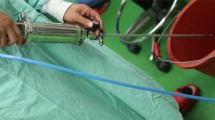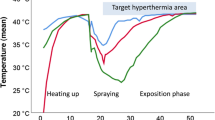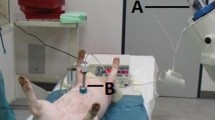Abstract
Background
We developed a novel drug delivery system called hyperthermic pressurized intraperitoneal aerosol chemotherapy (HPIPAC) that hybridized Hyperthermic intraperitoneal chemotherapy (HIPEC) and pressurized intraperitoneal aerosol chemotherapy (PIPAC). The present study aims to assess the feasibility and safety of HPIPAC system in a large animal survival model.
Methods
Eleven pigs (eight non-survival models and three survival models) were used in the experiment. The heat module in the HPIPAC controller circulates hyperthermic CO2 in a closed-loop circuit and creates gas-based dry intraperitoneal hyperthermia. Three 12 mm trocars were placed on the abdomen. The afferent CO2 tube wound with heat generating coil was inserted into a trocar, and the efferent tube was inserted into another trocar. Heated CO2 was insufflated and circulated in a closed circuit until the intra-abdominal and peritoneal surface temperature reached 42 °C. 100 ml of 5% dextrose in water was nebulized for 5 min and the closed-loop circulation was resumed for 60 min at 42 °C. Tissue biopsies were taken from several sites from the pigs in the survival model.
Results
The average change in core temperature of the pigs was 2.5 ± 0.08 °C. All three pigs displayed no signs of distress, and their vital signs remained stable, with no changes in their diet. In autopsy, inflammatory and fibrotic responses at the biopsy sites were observed without serious pathologic findings.
Conclusions
We successfully proved the feasibility and safety of our novel HPIPAC system in an in-vivo swine survival model.
Graphical abstract




Similar content being viewed by others
References
Lee JH, Son SY, Lee CM, Ahn SH, Park DJ, Kim HH (2014) Factors predicting peritoneal recurrence in advanced gastric cancer: implication for adjuvant intraperitoneal chemotherapy. Gastric Cancer: Offi J Int Gastric Cancer Assoc Jpn Gastric Cancer Assoc 17:529–536
Thomassen I, van Gestel YR, van Ramshorst B, Luyer MD, Bosscha K, Nienhuijs SW, Lemmens VE, de Hingh IH (2014) Peritoneal carcinomatosis of gastric origin: a population-based study on incidence, survival and risk factors. Int J Cancer 134:622–628
Foster JM, Zhang C, Rehman S, Sharma P, Alexander HR (2023) The contemporary management of peritoneal metastasis: a journey from the cold past of treatment futility to a warm present and a bright future. CA Cancer J Clin 73:49–71
Casella F, Bencivenga M, Rosati R, Fumagalli UR, Marrelli D, Pacelli F, Macri A, Donini A, Torroni L, Pavarana M, De Manzoni G (2022) Pressurized intraperitoneal aerosol chemotherapy (PIPAC) in multimodal therapy for patients with oligometastatic peritoneal gastric cancer: a randomized multicenter phase III trial PIPAC VEROne. Pleura Peritoneum 7:135–141
Dedrick RL, Myers CE, Bungay PM, DeVita VT (1978) Pharmacokinetic rationale for peritoneal drug administration in the treatment of ovarian cancer. Cancer Treat Rep 62:1–11
Kobayashi D, Kodera Y (2017) Intraperitoneal chemotherapy for gastric cancer with peritoneal metastasis. Gastric Cancer 20:111–121
Ishigami H, Fujiwara Y, Fukushima R, Nashimoto A, Yabusaki H, Imano M, Imamoto H, Kodera Y, Uenosono Y, Amagai K, Kadowaki S, Miwa H, Yamaguchi H, Yamaguchi T, Miyaji T, Kitayama J (2018) Phase III trial comparing intraperitoneal and intravenous paclitaxel plus S-1 versus cisplatin plus S-1 in patients with gastric cancer with peritoneal metastasis: PHOENIX-GC trial. J Clin Oncol: Off J Am Soc Clin Oncol 36:1922–1929
Granieri S, Bonomi A, Frassini S, Chierici AP, Bruno F, Paleino S, Kusamura S, Germini A, Facciorusso A, Deraco M, Cotsoglou C (2021) Prognostic impact of cytoreductive surgery (CRS) with hyperthermic intraperitoneal chemotherapy (HIPEC) in gastric cancer patients: a meta-analysis of randomized controlled trials. Eur J Surg Oncol 47:2757–2767
Alyami M, Hubner M, Grass F, Bakrin N, Villeneuve L, Laplace N, Passot G, Glehen O, Kepenekian V (2019) Pressurised intraperitoneal aerosol chemotherapy: rationale, evidence, and potential indications. Lancet Oncol 20:e368–e377
Cheng Y, Weng S, Yu L, Zhu N, Yang M, Yuan Y (2019) The role of hyperthermia in the multidisciplinary treatment of malignant tumors. Integr Cancer Ther 18:1534735419876345
Jung DH, Son SY, Oo AM, Park YS, Shin DJ, Ahn SH, Park DJ, Kim HH (2016) Feasibility of hyperthermic pressurized intraperitoneal aerosol chemotherapy in a porcine model. Surg Endosc 30:4258–4264
Ajani JA, D’Amico TA, Bentrem DJ, Chao J, Cooke D, Corvera C, Das P, Enzinger PC, Enzler T, Fanta P, Farjah F, Gerdes H, Gibson MK, Hochwald S, Hofstetter WL, Ilson DH, Keswani RN, Kim S, Kleinberg LR, Klempner SJ, Lacy J, Ly QP, Matkowskyj KA, McNamara M, Mulcahy MF, Outlaw D, Park H, Perry KA, Pimiento J, Poultsides GA, Reznik S, Roses RE, Strong VE, Su S, Wang HL, Wiesner G, Willett CG, Yakoub D, Yoon H, McMillian N, Pluchino LA (2022) Gastric cancer, version 2.2022, NCCN clinical practice guidelines in oncology. J Natl Compr Canc Netw 20:167–192
Kim TH, Kim IH, Kang SJ, Choi M, Kim BH, Eom BW, Kim BJ, Min BH, Choi CI, Shin CM, Tae CH, Gong CS, Kim DJ, Cho AEH, Gong EJ, Song GJ, Im H-S, Ahn HS, Lim H, Kim HD, Kim JJ, Yu JI, Lee JW, Park JY, Kim JH, Song KD, Jung M, Jung MR, Son SY, Park SH, Kim SJ, Lee SH, Kim TY, Bae WK, Koom WS, Jee Y, Kim YM, Kwak Y, Park YS, Han HS, Nam SY, Kong S-H (2023) Korean practice guidelines for gastric cancer 2022: an evidence-based. Multidiscip Approach J Gastric Cancer 23:3
Chidambaram S, Guiral DC, Markar SR (2023) Novel multi-modal therapies and their prognostic potential in gastric cancer. Cancers 15:3113
Nagy JA, Chang SH, Shih SC, Dvorak AM, Dvorak HF (2010) Heterogeneity of the tumor vasculature. Semin Thromb Hemost 36:321–331
Heldin CH, Rubin K, Pietras K, Ostman A (2004) High interstitial fluid pressure—an obstacle in cancer therapy. Nat Rev Cancer 4:806–813
Flessner MF (2005) The transport barrier in intraperitoneal therapy. Am J Physiol-Renal Physiol 288:F433–F442
Ceelen WP, Flessner MF (2010) Intraperitoneal therapy for peritoneal tumors: biophysics and clinical evidence. Nat Rev Clin Oncol 7:108–115
Kepenekian V, Bhatt A, Péron J, Alyami M, Benzerdjeb N, Bakrin N, Falandry C, Passot G, Rousset P, Glehen O (2022) Advances in the management of peritoneal malignancies. Nat Rev Clin Oncol 19:698–718
González-Moreno S, González-Bayón LA, Ortega-Pérez G (2010) Hyperthermic intraperitoneal chemotherapy: rationale and technique. World J Gastrointest Oncol 2:68–75
Solass W, Kerb R, Mürdter T, Giger-Pabst U, Strumberg D, Tempfer C, Zieren J, Schwab M, Reymond MA (2014) Intraperitoneal chemotherapy of peritoneal carcinomatosis using pressurized aerosol as an alternative to liquid solution: first evidence for efficacy. Ann Surg Oncol 21:553–559
Bachmann C, Sautkin I, Nadiradze G, Archid R, Weinreich FJ, Konigsrainer A, Reymond MA (2021) Technology development of hyperthermic pressurized intraperitoneal aerosol chemotherapy (hPIPAC). Surg Endosc 35:6358–6365
Thelen S, Mikolajczyk-Martinez A, Diakun A, Khosrawipour T, Zielinski K, Nicpon J, Kielbowicz Z, Przadka P, Liszka B, Kuropka P, Li S, Lau H, Kielan W, Khosrawipour V (2022) Evaluating the concept of gas-based intraperitoneal hyperthermia beyond 43 C in the treatment of peritoneal metastasis: a pilot study. Exp Ther Med 24:752
Pocard M, So JBY, Huchon C, Robella M, Chavatte-Palmer P, Eveno C, Glehen O, Peng Yong W (2023) PIPAC nebulizer: How to test the new devices in the market, expert recommendations. J Visc Surg 160:52–54
Acknowledgements
The HPIPAC System was assembled by Dr Koo Tae Kang from Nextech Co. according to our specifications.
Funding
This study received funding from Seoul National University Bundang Hospital (Grant Nos. SNUBH 02-2017-0049, 14-2018-0004, 14-2019-0004).
Author information
Authors and Affiliations
Corresponding author
Ethics declarations
Disclosures
Sa-Hong Min, Mira Yoo, Duyeong Hwang, Eunju Lee, So Hyun Kang, Sangjun Lee, Yongjoon Won, Young Suk Park, Sang-Hoon Ahn, Hyung-Ho Kim have no conflicts of interest or financial ties to disclose.
Additional information
Publisher's Note
Springer Nature remains neutral with regard to jurisdictional claims in published maps and institutional affiliations.
Supplementary Information
Below is the link to the electronic supplementary material.
Rights and permissions
Springer Nature or its licensor (e.g. a society or other partner) holds exclusive rights to this article under a publishing agreement with the author(s) or other rightsholder(s); author self-archiving of the accepted manuscript version of this article is solely governed by the terms of such publishing agreement and applicable law.
About this article
Cite this article
Min, SH., Yoo, M., Hwang, D. et al. Hyperthermic pressurized intraperitoneal aerosol drug delivery system in a large animal model: a feasibility and safety study. Surg Endosc 38, 2062–2069 (2024). https://doi.org/10.1007/s00464-024-10702-4
Received:
Accepted:
Published:
Issue Date:
DOI: https://doi.org/10.1007/s00464-024-10702-4




